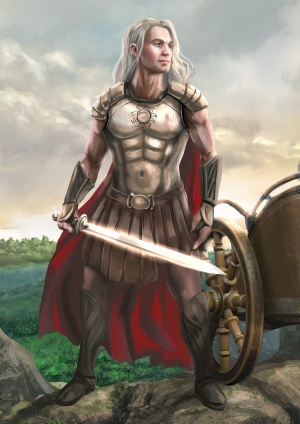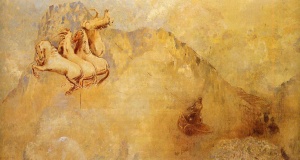Difference between revisions of "Arathrax"
Trismegistus (talk | contribs) m |
Trismegistus (talk | contribs) |
||
| Line 42: | Line 42: | ||
=Names of Arathrax= | =Names of Arathrax= | ||
| − | Believers have many names for Arathrax, including 'Son of Amrulon,' 'Firstborn of Amrulon,' 'Father of the Blessed Eight,' and the very frequent 'Lord and Savior.' | + | Believers have many names for Arathrax, including 'Son of Amrulon,' 'Firstborn of Amrulon,' 'Father of the Blessed Eight,' and the very frequent 'Lord and Savior.' In ceremonies performed in the Temple of Arathrax, he is sometimes addressed as 'Father and Son.' |
| − | |||
=See Also= | =See Also= | ||
Revision as of 21:14, 28 June 2020
Arathrax is an Isxinthion Solar Deity. According to legend, Arathrax is the firstborn issue of Amrulon and Eriu. He is a great solar divinity in his own right and the patron god of inherited kingship.
As the progenitor of the demi-mortal Arathracian Race, Arathrax is held with immense esteem by the worshipers of the Arathracian Religion. His role in the Arathracian Religion was transformed and he became the central figure, eclipsing even his parents, the supreme sun gods, Amrulon and Eriu. After the passing of the Yophenthean Empire, the role of Arathrax underwent transformation. The legendary Edict of Amrulon is held to capture the motivation behind many of these changes. Arathrax continues to form many primary functions in the liturgical practices of the Yophenthean Church. His portfolio adopted the sphere of filial devotion to one’s parents, especially one’s father. Heirs, princes, future rulers, and those of Yophenthean heritage often worship him.
He is the rescuer of his brother, Rhio, from the Chaos Gods who kidnapped him. Arathrax struggled indirectly against his half-brother, Thwar and their conflict mirrors the conflict between the Sun Gods and the Sky Gods especially during the late first millennium after Salmakhamer. Arathrax is held to represent lawful order, lawful succession of hereditary monarchy, and the orderly progression of the sun through the year and the zodiac. Arathrax shares many of his holy days with his father Amrulon and other sun gods, especially the solstices. He is protector of crops, harvests, and his priests instruct farmers to know best when to plant crops and when to harvest them.
Depiction in Art
In art, Arathrax is depicted in many ways. The most common shows him standing in a golden chariot pulled by sixteen horses, representing the sixteen months of the solar year. He bears a helmet, a breastplate, and sword of beaming gold, along with a cuirass and boots of golden cowhide. He is the most important of the solar divinities, after Amrulon. He is the bearer of the sun and considered a manifestation of the sun. In the Arathracian Religion, he is the most important sun god.
Rescue of Rhio
In myth, Arathrax rescues his younger brother, the solar and wine god, Rhio, from the gods of chaos. Rhio was kidnapped or abducted by the gods of chaos to dwell with them. Arathrax defeats the gods of chaos and brings his brother back to Isxinthios. The myth has been interpreted by some as representative of the conflict between the irrational (Rhio) and the rational (Arathrax).
Death and Resurrection of Arathrax
Arathrax's death and resurrection is re-enacted every year on winter solstice. Arathrax dies and rises from the death and with his resurrection attains the power to raise his family members from the power of death to the realm of Eránatazar. This process was re-enacted in secret sacraments known only to initiates, the most sacred components of the so-called Rites of Arathrax.
In the holy account re-enacted in temple sacraments, the wicked god Threy steals the sixteen steeds of the sun from Arathrax and rides the chariot of the sun in the underworld to give to his father, Orclanx, threatening to destroy the order of the universe. Arathrax confronts Threy and defeats him with great violence and then recovers the chariots, thus restoring the order of the universe. Threy is humiliated and wrathful and plots the demise of Arathrax. Threy disturbs the dragon, Talithuz, who slumbers in the depths of the earth. She arises in the night and surprises Arathrax who is asleep with his sixteen steeds. She overtakes him and slays him, then falls back asleep in the depths due to exhaustion. Threy rejoices, takes his slain body, and divides it into fifteen pieces which he casts into the sea. Elystra, the heavenly consort of Arathrax, with the help of Skiánthra, recovers the fifteen parts of the body of Arathrax. She cannot find his phallus and asks the god Eshik for help. He constructs a golden phallus for her. She gathers the fifteen plus one pieces together. Then in the depths of the earth in the house of Talithuz, Elystra discovers the knowledge of life and death. She uses this knowledge to raise Arathrax from the dead on winter solstice. However, she awakens the dragon, Talithuz, who slays her. Arathrax arises from the dead and confronts Talithuz. Since he has already been slain by the dragon and raised from the dead, he can never be slain by her again. They fight and he defeats her, binding her to the underworld. He uses the knowledge gained in the underworld to raise his wife, Elystra, from the dead. They return triumphantly to the world of living. Arathrax confronts Threy and says he now has the power to restore the dead to life in the world of Eránatazar where they shall enjoy eternal life rather than merely another mortal life.
This legend is considered to be pre-Arathracianist, that is, before the rise of Arathracianism. Some scholars believe certain aspects of the legend were added afterwards during the Arathracian Period, such as the slaying and revival of the goddess Elystra.
Chariot of Arathrax
Arathrax is often depicted in poetry and art driving the chariot of the sun in behalf of his father, Amrulon. Sixteen steeds draw the splendid golden chariot across the sky. The chariot represents the sun in his course across the sky through the solar or holy year.
Arathrax in Arathracian Theology
Arathrax is called "Father and Son," the Father, because he is the father of Erithraigean and the other seven of the Eight Sons of Aireánnau, and the Son, because he is the firstborn son of the god Amrulon. According to Arathracian Theology, Arathrax has replenished the human race through his demi-mortal offspring, enriching mankind and enabling his followers to bless and enrich other humans.
Arathrax's relationship to Elystra is seen as the perfected divine relationship between the masculine and feminine principles. The relationship between Arathrax and Aireánnau is seen as the connection made possible between the divine and the mortal.
Skiánthra
Lord Skiánthra is the servant and totemic beast of Arathrax who bears the god's missions and commendations to mortals on earth and serves as an intermediary between gods and mortals. Skiánthra appears as a giant golden eagle and is called Lord of Golden Eaglekind. In Arathracian theology, Skiánthra is the means by which the sacred seed of Arathrax was transmitted to the pool of water in which the maiden Aireánnau bathed and conceived each demi-mortal son of Arathrax, in his turn. Thus, Skiánthra is seen as an intermediary between humans and the god Arathrax.
Father of Arathraciots
Arathrax is regarded as the father of the Arathraciot Demi-Mortal race. Just as Elystra is the heavenly companion of Arathrax, Aireánnau was his earthly consort, raised to a heavenly afterlife. In later Arathracian thought, the role of Elystra was completely eclipsed by the ascended station of Aireánnau whose ascension foreshadowed the ascension of her son, Erithragean. Arathrax's conquest of death enabled him to raise the members of his family from death and thus to raise his followers from the power of death.
Names of Arathrax
Believers have many names for Arathrax, including 'Son of Amrulon,' 'Firstborn of Amrulon,' 'Father of the Blessed Eight,' and the very frequent 'Lord and Savior.' In ceremonies performed in the Temple of Arathrax, he is sometimes addressed as 'Father and Son.'
See Also
- Aireánnau Mother of the Folk
- Annunciation to Saint Aireánnau
- Deliverance of Saint Aireánnau
- Eight Sons of Aireánnau
- Isxinthion Gods
- Sixteen Tablets of Arathrax
- Skiánthra
- Sun Gods
| This article is a stub. It requires further development by the creator. |

